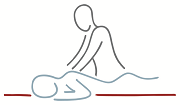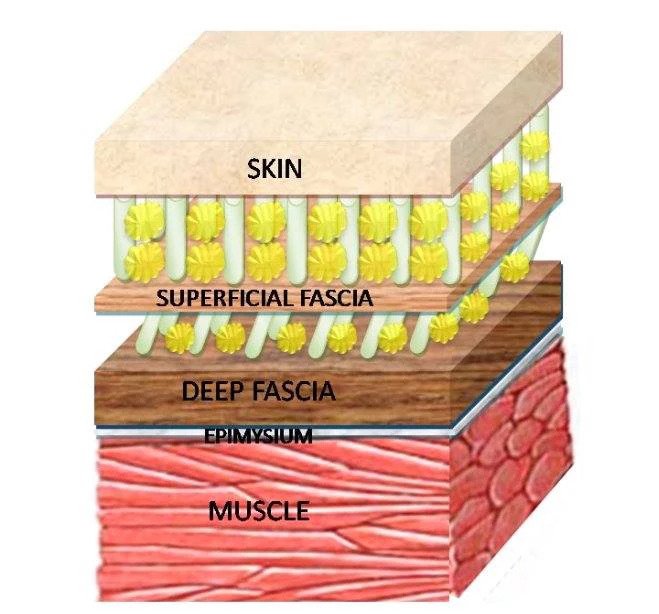Under our skin is a layer of irregular connective tissue that supports and surrounds all the muscles and organs of our body. It is known as Fascia and acts like an all over body stocking which connects everything together. Fascia is made up of a polysaccharide (Starch) complex called Ground Substance which is contained within a matrix of Elastin and Collagen (Protein) fibres. The proportion and distribution of these fibres varies dramatically in different areas of the body depending on local needs. Our Fascia can be thick and dense to form Tendons and Ligaments or very fine to wrap around each muscle fibre. The Elastin fibres are stretchy and the Collagen has great tensile strength so the combined properties can vary enormously. Fascia also carries nerves, blood and lymphatic vessels and fills spaces between muscles.
Three layers of connective tissue extend from the fascia to protect and strengthen skeletal muscles. These are all continuous with the tissue that attaches skeletal muscles to other structures, such as bone or another muscle. (e.g. tendon, ligament or joint capsules).
The three layers of connective tissue are:
Epimysium – surrounds the whole muscle. This provides a lubricated surface so that the muscles can move smoothly against other bodily structures.
Perimysium – surrounds groups of 10-100 muscle fibres to form bundles called fascicles.
Endomysium – Mostly made of reticular fibres, this surrounds each muscle fibre within the bundle.
The fascia holds the muscle together and keeps it in the correct place. It also separates the muscles so they can work independently of each other.
Each muscle is part of the chain of fascia that runs through the body. When one muscle contracts, others in the chain have to respond and assist in the function. The fascial connections may also create tension and movements in other directions and joints need to be stabilised. This means that the whole system is working together to perform the movement.
When no movement takes place for a while (e.g. when asleep overnight), the fascia starts to form small fibrous bonds with the neighbouring tissues. These easily break down when movement does occur, but that is why we feel stiff and in need of a stretch each morning. Prolonged lack of movement in local areas allows these bonds to increase and strengthen. They are not then easily broken by a quick stretch. The bonds start to restrict movement and a vicious cycle starts which inhibits normal range of motion. Muscle stretching alone will not release the fascial tension and Soft Tissue Therapy will be needed to break the bonds. Remedial exercises and postural improvement will only be effective after the fascia has been released.
If we look at Fascia as a web or net we can imagine what happens to it when strands get stuck together. This could be because of scarring from surgery or adhesions in overused and tense muscles.. The shape of the fascia changes as well as the tension lines within it. These changes can cause disfunction and pain throughout the body.
Soft Tissue Therapy and Scarwork™ use a number of hands-on techniques that help to ease out these “stuck” patches and improve the way our bodies perform. If you would like to discuss how I can help you to keep your Fascia in tip top condition, please get in touch.

